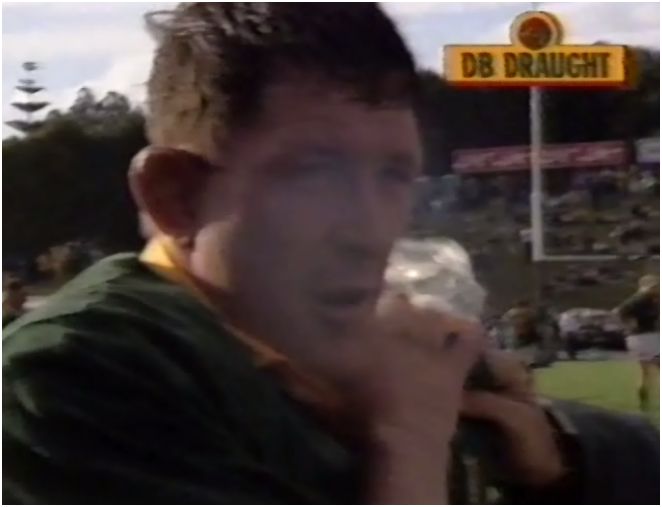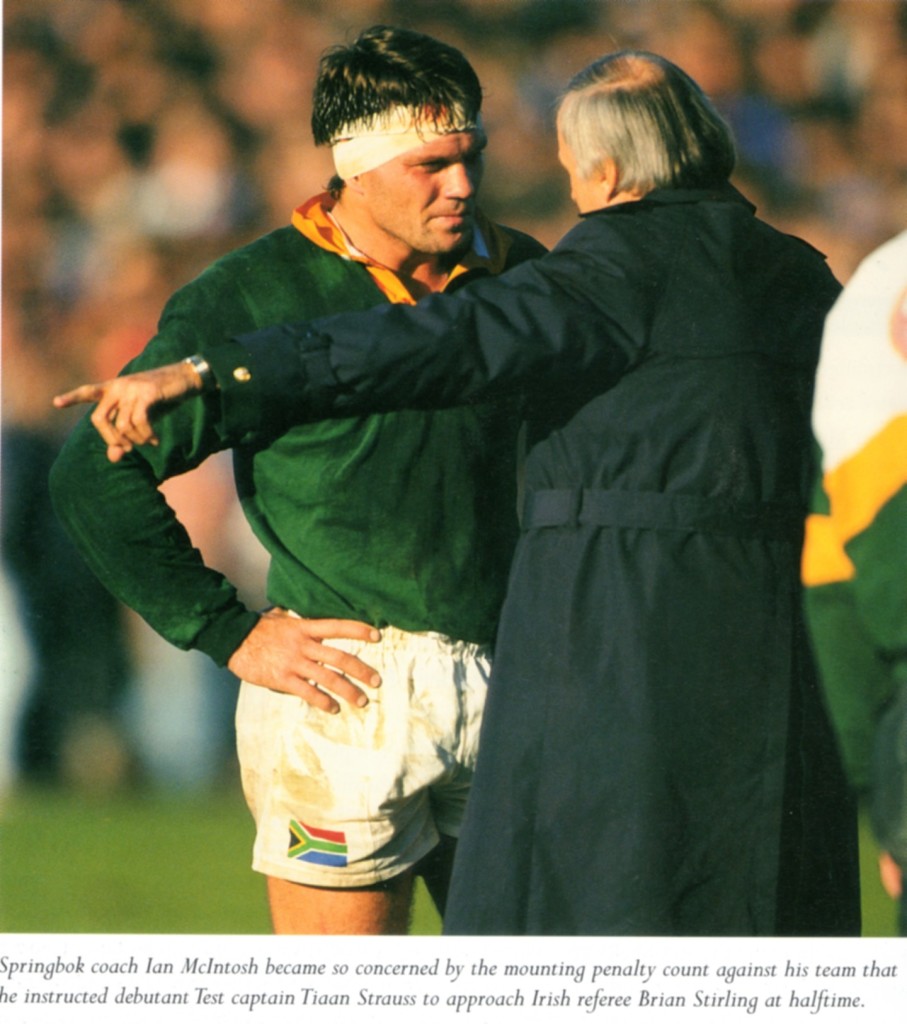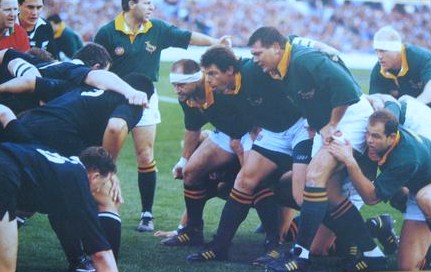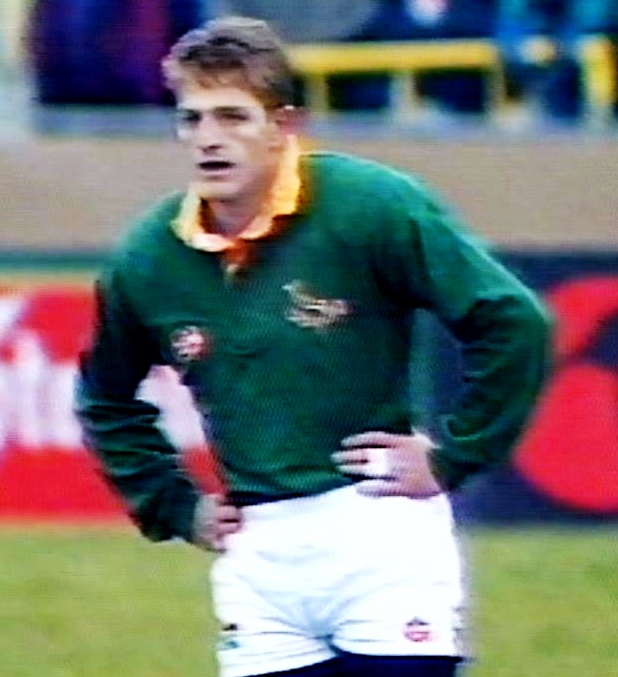
 The 1994 Springbok team is regarded as the worst Springbok side visiting New Zealand. They were unable to win a single test –losing the first two and drawing the 3rd test- and losing one provincial match out of 11 against Otago (12-19).
The 1994 Springbok team is regarded as the worst Springbok side visiting New Zealand. They were unable to win a single test –losing the first two and drawing the 3rd test- and losing one provincial match out of 11 against Otago (12-19).
In total they lost 3 matches and drew one out of 14 matches. Compared to the 1965 Springboks probably a better overall result; excluding the fact that they couldn’t win a test match. It was nonetheless a disappointing result considering the fact that this team also completed tours -with the same coach, Ian McIntosh- through Australia and Argentina in 1993. They won one test in Australia and both test matches in Argentina with reasonable good margins. In addition they played two test matches against England at the start of the 1994 season losing the first one 15-32 at Loftus Versfeld and winning the second one 27-9 at Newlands in Cape Town. From that backdrop there was understandingly an expectation that SA rugby and particular the Springboks will shed the impact of the isolation years and begin to adjust to the requirements of the international rugby if not win test matches.
In addition there was an aura of expectation with regard to the New Zealand tour amongst the connoisseur rugby followers in South Africa because New Zealand -at the time- seemed absolutely ripe for the plucking. The All Blacks were playing in an overlapping series against France and where besieged with problems of their own. The French were playing an exciting and attractive style of rugby scoring brilliant tries and the New Zealand public were getting increasingly annoyed with All Black team’s inability to field an effective backline combination particularly in the midfield.
Coach Laurie Mains was under pressure and fending a strong challenge from Auckland coach John Hart. The multiple amounts of debates raging over talkback radio, television and newspapers indicated that the election of the All Black coach was of more importance to the nation than any parliamentary election. By the time of the first test between South Africa and New Zealand eventuated the All Blacks had lost both test matches against France at home. It was a tentative but desperate New Zealand side lacking confidence that lined-up for the first test of the series against South Africa. It was a test that New Zealand simply could not afford to lose. In the dressing room before the test Captain Sean Fitzpatrick told his players that it was a case of winning or being issued with razor blades; committing hara-kiri.
South Africa, however, was not brimming with confidence upon arrival in New Zealand on Tuesday, 21 June 1994. The Springboks had yet to reassert themselves as a top rugby-playing nation. They had won only 5 out of 13 test matches since losing the return match against the All Blacks at Ellispark in 1992.
In hindsight a number of aspects can be isolated which went wrong on the 1994 tour; there was squad selection; injuries; coach under pressure; players not being streetwise enough and referee/ill-discipline issues all of which played a role in the team’s inability to find rhythm and score tries in tight situations. The worst mistake was going on tour without a recognised goal kicker; both the first and third test matches could have been won if not for missed penalty kicks.
Ultimately, it was the fact that SA rugby was still struggling with the demons of 13 years of isolation that caused South Africa to lose a series that could have been won. Coach McIntosh was battling to convince players and administrators of the merits of 15-man rugby. The fact that South Africa played a more attractive brand of rugby than the All Blacks but still lost –due to lack of a recognised kicker- did not help McIntosh to keep his job. Neither did the team’s inability to maintain momentum because it lacked discipline and structure at the tackle ball. A harrowing Louis Luyt –attending most of the matches- and the South African public was not convinced that test matches can be won by throwing the ball around. As a South African supporter it did feel like a situation of South Africa losing it and not one of New Zealand winning it.
There were however more to the story than the type of rugby McIntosh had his stooges playing.
At play were a few insidious cancers that were at large in the SA rugby which players, coaches and administrators were slow to recognise and address.
Provincialism has been a long standing problem in SA rugby and it was an open secret that Coach Ian McIntosh didn’t get the team he wanted. Uli Schmidt for one didn’t make himself available because he was not happy with the prop forwards selected.
The teams that played in 1993 (Australia and Argentina) and the one touring to New Zealand in 1994 can be seen in the table below. Notice the multiple changes to the midfield, the locks (some forced by injury) and the frontrow. It is no co-incidence that the midfield, the line-out and the frontrow was the problem areas for South Africa during the 1994 tour.
It is a mystery to me why Honiball and Stransky did not go on the 1994 tour (maybe they were injured or unavailable). Why was Teichman (after having been selected for the Argentinian tour) left at home for a player like Adriaan Richter? Johan Styger was regarded by the Australians in 1993 as the best scrummager in the Springbok side yet he was not selected. Instead loose cannon Johan le Roux went on tour.
| 1993 to Australia | 1993 to Argentina | 1994 to New Zealand |
| Fullbacks | ||
| Hugh Reece-Edwards
Andre Joubert Theo van Rensburh |
Chris Dirks
Andre Joubert Gavin Johnson |
Theo van Rensburg
Andre Joubert Gavin Johnson (replaced van Rensburg) |
| Wings | ||
| Jacques Olivier
Chester Williams James Small Deon Oosthuysen |
Jacques Olivier
Chester Williams James Small |
Chris Badenhorst
James Small Kabous van der Westhuizen Chester Williams |
| Centres | ||
| Heinrich Fulls
Pieter Muller Henry Honiball Tinus Linee |
Heinrich Fulls
Hennie le Roux Pieter Muller |
Jannie Claassens
F.A Meiring Brendan Venter Pieter Muller Japie Mulder (replaced Pieter Muller) |
| Flyhalves | ||
| Hennie le Roux
Joel Stransky |
Joel Stransky
Henry Honiball |
Hennie le Roux
Lance Sherrel |
| Scrumhalves | ||
| Robert du Preez
Joost van der Westhuizen |
Joost van der Westhuizen
Hentie Maartens |
Johan Roux
Joost van der Westhuizen |
| No 8 loose forwards | ||
| Adriaan Richter
Tiaan Strauss |
Tiaan Strauss
Gary Teichman |
Adriaan Richter
Tiaan Strauss |
| Flankers | ||
| Deon Lotter
Ian MacDonald Ruben Kruger François Pienaar |
François Pienaar
Wahl Bartman Mark Andrews Ruben Kruger |
Wahl Bartmann
Ruben Kruger François Pienaar Fritz van Heerden Rudolf Straueli (replaced Ruben Kruger) |
| Lock forwards | ||
| Nico Wegner
Steve Atherton Hannes Strydom Kobus Wiese Rudi Visagie |
Nico Wegner
Hannes Strydom Steve Atherton |
Mark Andrews
Steve Atherton Kobus Wiese Adri Geldenhuys (replaced Wiese) Krynuaw Otto Nico Wegner (replaced Otto) |
| Front rowers | ||
| Heinrich Rogers
Balie Swart Johan Styger Keith Andrews Willie Hills |
Guy Kebble
Ollie le Roux Keith Andrews Balie Swart |
Keith Andrews
Guy Kebble Johan le Roux Ollie le Roux Balie Swart |
| Hookers | ||
| Uli Schmidt
John Allan |
Naka Drotske
John Allan |
John Allan
James Dalton |
| Coaches | ||
| Ian McIntosh
Gysie Pienaar |
Ian McIntosh
Gysie Pienaar |
Ian McIntosh
Gysie Pienaar |
| Manager | ||
| Jannie Engelbrecht | Jannie Engelbrecht | Jannie Engelbrecht |

Wahl Bartmann who left for home after getting injured in the 2nd tour match against Counties.
The Springboks –probably partially due to breaking-up the squads that went on tour in 1993 but also due to the fact that New Zealand played a different style of rugby than Australia and Argentina- struggled to get momentum right from the very first game.
Decision making with ball in hand and silly mistakes like botching-up kick-offs, poor throw-ins at the line-out and penalties at the tackle ball were the main culprits. The scoreboard did not always reflect how challenging they found some of the tour matches. One gets a distinct feeling -looking at replays of tour and test matches- that there was not enough attention to detail on the training paddock. The problem of throwing 50/50 passes and of backline play breaking down between numbers 9, 10 and 12 seems to have been a persistent problem that was never adequately addressed/solved; it kept-on featuring up to the last test match.
The third cancer was ill-discipline.
World rugby was busy cleaning up its act and the pugnacious South African players were at pains to re-adjust to the high standard of discipline required at international level. Trigger happy referees and streetwise New Zealand players -quick to milk the re-active truculent constitution of the South Africans to their advantage- conspired into situations where the Springboks lost the plot in virtually all three test matches.
The Springboks had opportunities to win all three test matches, but lost due to conceding crucial penalties and failing to convert penalties into points. In the first test both teams scored one try but Shane Howarth kicked five penalties to clinch the match for New Zealand. The Springboks started the match with such ferocity that they could have won the match in the first quarter if it wasn’t for their impatience and inability to maintain phase play. The Boks enjoyed 75% territorial advantage in the first 20 minutes and three times came close to scoring. The backs were running confidently from within their own 22-meter area and the forwards were mauling effectively and with discipline.
Unfortunately, Ireland referee Brain Stirling spoiled the party and played a major role in the home team’s ability to ride the tide and building up a 12-3 halftime lead. Rated just third in his own country here was Stirling in charge of the most intense Test rivalry in world rugby. Seen slumped and completely exhausted in the referee room after the game it was clear that the perceptions -as the match progressed- that he was out of his depth was correct. So incensed was Ian McIntosh with the first half 12-4 penalty and free kick count in favour of the All Blacks that he instructed stand-in Captain Tiaan Strauss to start querying Stirling.

Springbok coach having an animated discussion with Tiaan Strauss during the halftime break of the first test.
Ian McIntosh was right to be frustrated at halftime with the All Blacks’ tactics and referee Stirling’s inability to keep up. Stirling embarked on one of his many schoolmasterly lectures when the tempers flared for the first time in the match. This flare-up resulted when Robin Brooke committed a professional foul by playing the ball openly with his hand in a ruck with the Springboks on a strong attacking flow. Stirling’s obtuse interpretation of the situation just increased the South African players frustration. His imperceptions continued to incense the Springboks when he missed the way the All Blacks responded to the pressure exerted upon them by frequently drifting offside and by mountaineering in the rucks and mauls. The temperature raised another notch when Balie Swart had to leave the field after one of those frightening pile-ups. This shifted the balance in power and the New Zealand pack started to dominate. Under pressure the Springboks frustration turned too ill-discipline. Johan le Roux was twice penalised for obvious offences.

When Balie Swart had to leave the field in the first test
New Zealand started to dominate in the scrums.
Staggering against the cumulative amount of penalties and free kicks the inexperienced Springboks –unsure about the offside law and Stirling’s fuzzy interpretations- became tentative at the breakdowns. At the lineouts the ball always went to Mark Andrews and the All Blacks -quick to pick that up- started to make life very difficult for him. The Springboks became increasingly more distracted even though at that stage they were back in the game (12-11) as a result of a try by Rudolf Straueli and a Joubert penalty. Had Joubert goal kicked more accurately the tide might have turned.
In the end it was ill-discipline that proved to be the decisive factor as it was a reversed penalty that took the match away from the Springboks.
When the touch judge intervened to point out that Johan le Roux had stomped on Fitzpatrick, in the 23rd minute of the second half, a kickable penalty awarded to South Africa, was reversed. New Zealand kicked the ball up-field and from the resulting line-out swept on attack winning ruck after ruck until Kirwan were given enough space to run in a try. Fact that the reversed penalty was awarded against Zinzan Brooke for playing the ball while on the ground did not improve the mood in the Springbok team at that stage. The score went to 21-11 for the All Blacks –where 5 minutes before it could have been 16-12 in the Springboks favour – when Stirling awarded yet another penalty against the Springboks.
Then an incident that would eventually determine the fate of Johan le Roux was again totally misinterpreted and wrongly officiated by the incompetent referee. Stirling, whose performance in the last 10 minutes bordered on hysterical, saw fit to only warn Le Roux when he reacted to being kicked between the legs in a ruck by Fitzpatrick. This set Le Roux up to do something really stupid in the second test that would end his international rugby career.
Ian McIntosh barred his teeth at the post-match conference. Inconsistent interpretations of ruck and maul laws and allegations of All Black illegalities like barging at the lineout and collapsing the scrum were on the agenda. But a pattern had been set. A pattern of judicious and cunning All Blacks constantly riding on the edge of the law -looking utterly innocent when caught in the act – was in place. Sean Fitzpatrick in particular took milking penalties and manipulating the referee to a new level. On the South African side a pattern of tentativeness and law interpretation uncertainties at the tackle ball had been established.
When it comes to the second test of this series South Africa was its own worst enemy. The problems started with ill-discipline in the week before the second test. First, James Small went mental in the game against Ranfurly Shield holder Waikato. His antics started when he recklessly charged into a line-out and knocked Waikato lock Steve Gordon unconscious with his knee. He then continued with his inappropriate behaviour by blowing kisses to a Waikato player -when scoring a try- and gesticulating rudely to another after a long chase back on defence. The crowd and media were incensed; it became a witch hunt. So much so that broadcaster Murray Deaker called Small a ‘nutter’, on national TV before adding, ‘What would you expect from a bloke who says he’s used dope?’
With the Springbok management considering legal action against national TV the NZRFU judiciary with a mind on ‘ensuring the good of the tour’ took -to everyone surprise- no action against Small. Like a stalker on the prowl New Zealand television now intensified their scrutiny of Springbok behaviour from here on forward. In the very next match against Manawatu a punch by Adri Geldenhuys was pinpointed and highlighted to the extent that he was banned for a week while worst acts of violence by local players were not shown at all on news and rugby talk programs.
In the second test Springbok courage and enterprise were nullified by own errors while ill-discipline was yet again exploited by New Zealand gamesmanship. New Zealand players in contrast entered the realm of angelic beings; white as snow and faultless in execution. The first New Zealand try for instance was so well constructed and so beautiful in execution that the referee overlooked the fact that the All Black pack had gone over the top in the build-up. Shortly afterwards with New Zealand leading 5-3 Fitzpatrick stood up from a collapsed scrum and punched François Pienaar openly without so much as a murmur from the referee or linesmen.
South Africa was leading 6-5 when Theo van Rensburg carried the ball over his own line and into touch-in-goal to force a 5 meter scrum that resulted in a push-over try. This while Van Rensburg could have let the ball run roll out or he could have fallen on the ball to force it dead for a 22-metre drop-out. Worst was the fact that technically it was not a try. The ball emerged and re-entered the scrum before emerging again for Zinzan Brooke to score.

The inclusion of Theo van Rensburg as fullback in place of Andre Joubert in the hope that he
will sort Sout Africa’s place kicking woes was not a success story.
Playing against the wind in the second half South Africa started to claw their way back. They put together some good sequences even though the forwards were often guilty of taking the ball too far and getting isolated and penalised. Johan Roux came agonisingly close to scoring. A scrum followed and All Blacks got penalised for collapsing the scrum on their line. While the obvious compensation should have been a penalty try Van Rensburg went forth and missed the kick. This could have taken the score to 12-10 (in case of converted penalty) or 16-10 (in case of penalty try under the posts) in South Africa’s favour. Unbelievingly, New Zealand then moved ahead 13-9 due to a penalty awarded for ‘sledging’; most probably the first and last time that a penalty was awarded for ‘sledging’ in a international rugby match. Meanwhile several blatantly high tackles by the All Black three quarters were overlooked by the referee.
Right at the end Fitzpatrick rubbed salt into the wounds by wasting time expertly, and finally the referee blew the game a minute short. It was pure agony for the South African fans; the 4th test of 1976 and Gert Bezuidenhout is not even a comparison.
The ignominy of South African rugby dropped to extreme uncomfortable levels in the aftermath of the match when TVNZ footage was revealed which captured Springbok prop Johan le Roux biting Sean Fitzpatrick’s ear.
The South African management acted swiftly and pre-empted the judiciary deliberations by sending le Roux home. His disgrace was completed the next week in Wellington when a judiciary committee banned him from rugby for 19 months, a penalty that was not reduced on appeal.
The media was having a field day with the pugnacious nature of South African rugby players the flavour of the month. A situation was created where New Zealand players could do nothing wrong while the slightest retaliation or acts of aggressive play by South African players resulted in lectures and penalties on the field and endless replays and discussions on television and radio.
Meanwhile back at the ranch Fitzpatrick continued his niggling and pestering so much so that South African public’s view of Sean Fitzpatrick turned from dislike to hatred. An elbow here, a jersey tug here, the use of an opponent’s face to help himself off the ground were all Fitzpatrick’s trademarks, and his disbelieving face when retaliation ensued was convincing. Brendon Venter’s flailing fists -provoked by a sneaky jersey tug- was one of 6 Shane Howarth penalties which helped New Zealand to a draw the last test match in spite of the fact that SA scored two tries against none.
New Zealand won the rugger but it was a bit of an empty victory. The NZ public knew that South Africa caused their own demise. Consequently, Laurie Mains’ whinging that he didn’t receive the recognition he deserved -for being the coach of the first NZ team that didn’t drop a match in a series against SA- had a bit of an empty sound to it. It was a case of lack of ‘pagodeneitelkeit’ as the German’s like to say; New Zealanders did not have that smug feeling of self-satisfaction that one who sits behind the wheel of a vintage car experiences.
New Zealand entered the Bledisloe Cup and lost both test matches against Australia giving them 2 wins out of 6 played for the season.
The South African team left for home and Engelbrecht and McIntosh got fired. There was a sense of ‘luftfahrtorigaminiedergesrhlageheit’ (that sense of deflation you experience when your diligently folded paper plane breaks immediately to the floor) when it comes to Springbok rugby for the fans at home. Quietly, however, -while condemning le Roux’s act on the one hand- most fans were wondering why biting is considered a worse crime than eye gouging or a kick to the groin.
Great article!
And that seems to the beginning of the perception that SA plays dirty rugby.
Users Online
Total 177 users including 0 member, 177 guests, 0 bot online
Most users ever online were 3735, on 31 August 2022 @ 6:23 pm